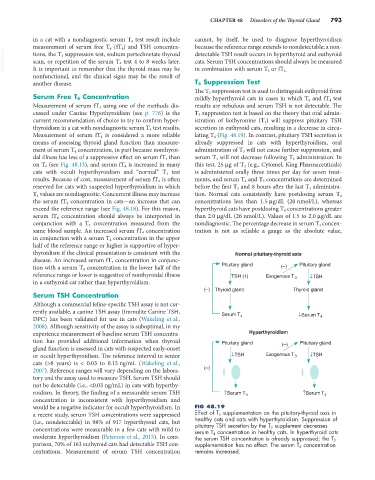Page 821 - Small Animal Internal Medicine, 6th Edition
P. 821
CHAPTER 48 Disorders of the Thyroid Gland 793
in a cat with a nondiagnostic serum T 4 test result include cannot, by itself, be used to diagnose hyperthyroidism
measurement of serum free T 4 (fT 4 ) and TSH concentra- because the reference range extends to nondetectable; a non-
VetBooks.ir tions, the T 3 suppression test, sodium pertechnetate thyroid detectable TSH result occurs in hyperthyroid and euthyroid
cats. Serum TSH concentrations should always be measured
scan, or repetition of the serum T 4 test 4 to 8 weeks later.
It is important to remember that the thyroid mass may be
nonfunctional, and the clinical signs may be the result of in combination with serum T 4 or fT 4.
another disease. T 3 Suppression Test
The T 3 suppression test is used to distinguish euthyroid from
Serum Free T 4 Concentration mildly hyperthyroid cats in cases in which T 4 and fT 4 test
Measurement of serum fT 4 using one of the methods dis- results are nebulous and serum TSH is not detectable. The
cussed under Canine Hypothyroidism (see p. 776) is the T 3 suppression test is based on the theory that oral admin-
current recommendation of choice to try to confirm hyper- istration of liothyronine (T 3 ) will suppress pituitary TSH
thyroidism in a cat with nondiagnostic serum T 4 test results. secretion in euthyroid cats, resulting in a decrease in circu-
Measurement of serum fT 4 is considered a more reliable lating T 4 (Fig. 48.19). In contrast, pituitary TSH secretion is
means of assessing thyroid gland function than measure- already suppressed in cats with hyperthyroidism, oral
ment of serum T 4 concentration, in part because nonthyroi- administration of T 3 will not cause further suppression, and
dal illness has less of a suppressive effect on serum fT 4 than serum T 4 will not decrease following T 3 administration. In
on T 4 (see Fig. 48.13), and serum fT 4 is increased in many this test, 25 µg of T 3 (e.g., Cytomel, King Pharmaceuticals)
cats with occult hyperthyroidism and “normal” T 4 test is administered orally three times per day for seven treat-
results. Because of cost, measurement of serum fT 4 is often ments, and serum T 4 and T 3 concentrations are determined
reserved for cats with suspected hyperthyroidism in which before the first T 3 and 8 hours after the last T 3 administra-
T 4 values are nondiagnostic. Concurrent illness may increase tion. Normal cats consistently have postdosing serum T 4
the serum fT 4 concentration in cats—an increase that can concentrations less than 1.5 µg/dL (20 nmol/L), whereas
exceed the reference range (see Fig. 48.18). For this reason, hyperthyroid cats have postdosing T 4 concentrations greater
serum fT 4 concentration should always be interpreted in than 2.0 µg/dL (26 nmol/L). Values of 1.5 to 2.0 µg/dL are
conjunction with a T 4 concentration measured from the nondiagnostic. The percentage decrease in serum T 4 concen-
same blood sample. An increased serum fT 4 concentration tration is not as reliable a gauge as the absolute value,
in conjunction with a serum T 4 concentration in the upper
half of the reference range or higher is supportive of hyper-
thyroidism if the clinical presentation is consistent with the Normal pituitary-thyroid axis
disease. An increased serum fT 4 concentration in conjunc-
tion with a serum T 4 concentration in the lower half of the Pituitary gland (–) Pituitary gland
reference range or lower is suggestive of nonthyroidal illness TSH (1) Exogenous T 3 ↓TSH
in a euthyroid cat rather than hyperthyroidism.
(–) Thyroid gland Thyroid gland
Serum TSH Concentration
Although a commercial feline-specific TSH assay is not cur-
rently available, a canine TSH assay (Immulite Canine TSH,
DPC) has been validated for use in cats (Wakeling et al., Serum T 4 ↓Serum T 4
2008). Although sensitivity of the assay is suboptimal, in my
experience measurement of baseline serum TSH concentra- Hyperthyroidism
tion has provided additional information when thyroid Pituitary gland (–) Pituitary gland
gland function is assessed in cats with suspected early-onset
or occult hyperthyroidism. The reference interval in senior ↓TSH Exogenous T 3 ↓TSH
cats (>8 years) is < 0.03 to 0.15 ng/mL (Wakeling et al.,
2007). Reference ranges will vary depending on the labora- (–)
tory and the assay used to measure TSH. Serum TSH should
not be detectable (i.e., <0.03 ng/mL) in cats with hyperthy-
roidism. In theory, the finding of a measurable serum TSH ↑Serum T 4 ↑Serum T 4
concentration is inconsistent with hyperthyroidism and
would be a negative indicator for occult hyperthyroidism. In FIG 48.19
a recent study, serum TSH concentrations were suppressed Effect of T 3 supplementation on the pituitary-thyroid axis in
(i.e., nondetectable) in 98% of 917 hyperthyroid cats, but healthy cats and cats with hyperthyroidism. Suppression of
pituitary TSH secretion by the T 3 supplement decreases
concentrations were measurable in a few cats with mild to serum T 4 concentration in healthy cats. In hyperthyroid cats
moderate hyperthyroidism (Peterson et al., 2015). In com- the serum TSH concentration is already suppressed; the T 3
parison, 70% of 163 euthyroid cats had detectable TSH con- supplementation has no effect. The serum T 4 concentration
centrations. Measurement of serum TSH concentration remains increased.

